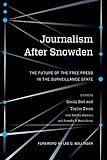Journalism After Snowden : The Future of the Free Press in the Surveillance State / ed. by Taylor Owen, Emily Bell.
Material type: TextSeries: Columbia Journalism Review BooksPublisher: New York, NY : Columbia University Press, [2017]Copyright date: ©2017Description: 1 online resourceContent type:
TextSeries: Columbia Journalism Review BooksPublisher: New York, NY : Columbia University Press, [2017]Copyright date: ©2017Description: 1 online resourceContent type: - 9780231176125
- 9780231540674
- Confidential communications -- Press -- United States
- Electronic surveillance -- Government policy -- United States
- Freedom of the press -- United States -- History -- 21st century
- Government and the press -- United States
- Journalism -- Political aspects -- United States -- History -- 21st century
- Leaks (Disclosure of information) -- United States
- LANGUAGE ARTS & DISCIPLINES / Journalism
- 070.4/3 23
- online - DeGruyter
- Issued also in print.
| Item type | Current library | Call number | URL | Status | Notes | Barcode | |
|---|---|---|---|---|---|---|---|
 eBook
eBook
|
Biblioteca "Angelicum" Pont. Univ. S.Tommaso d'Aquino Nuvola online | online - DeGruyter (Browse shelf(Opens below)) | Online access | Not for loan (Accesso limitato) | Accesso per gli utenti autorizzati / Access for authorized users | (dgr)9780231540674 |
Frontmatter -- Contents -- Foreword -- Acknowledgments -- Introduction -- I. The Story And The Source -- 1. Journalism After Snowden -- 2. In Defense Of Leaks -- 3. The Surveillance State -- 4. A Conversation With Edward Snowden -- II. Journalists And Sources -- 5. Source Protection In The Age Of Surveillance -- 6. Rescuing A Reporter'S Right To Protect The Confidentiality Of Sources -- 7. Digital Security For Journalists -- 8. Beyond PGP: How News Organizations Can And Must Protect Reporters And Sources At An Institutional Level -- 9. Freedom Of Information And Information Asymmetry -- III. Governing Surveillance -- 10. Political Journalism In A Networked Age -- 11. National Security And The "New Yellow Press" -- 12. A New Age Of Cyberwarfare -- 13. The Snowden Effect On The NSA And Reporting -- 14. Edward Snowden, His Passport, And The Legal Identity Of Americans -- 15. Surveillance Policy As Risk Management -- IV. Communications Networks And New Media -- 16. Silicon Valley And Journalism -- 17. Digital Threats Against Journalists -- 18. Fiber And Open Communications Networks -- 19. Free Thought, Free Media -- 20. Should Journalism Be A Surveillance-Safe Space? -- Postscript. Journalism After Snowden -- Contributors -- Index
restricted access online access with authorization star
http://purl.org/coar/access_right/c_16ec
Edward Snowden's release of classified NSA documents exposed the widespread government practice of mass surveillance in a democratic society. The publication of these documents, facilitated by three journalists, as well as efforts to criminalize the act of being a whistleblower or source, signaled a new era in the coverage of national security reporting. The contributors to Journalism After Snowden analyze the implications of the Snowden affair for journalism and the future role of the profession as a watchdog for the public good. Integrating discussions of media, law, surveillance, technology, and national security, the book offers a timely and much-needed assessment of the promises and perils for journalism in the digital age.Journalism After Snowden is essential reading for citizens, journalists, and academics in search of perspective on the need for and threats to investigative journalism in an age of heightened surveillance. The book features contributions from key players involved in the reporting of leaks of classified information by Edward Snowden, including Alan Rusbridger, former editor-in-chief of The Guardian; ex-New York Times executive editor Jill Abramson; legal scholar and journalist Glenn Greenwald; and Snowden himself. Other contributors include dean of Columbia Graduate School of Journalism Steve Coll, Internet and society scholar Clay Shirky, legal scholar Cass Sunstein, and journalist Julia Angwin. Topics discussed include protecting sources, digital security practices, the legal rights of journalists, access to classified data, interpreting journalistic privilege in the digital age, and understanding the impact of the Internet and telecommunications policy on journalism. The anthology's interdisciplinary nature provides a comprehensive overview and understanding of how society can protect the press and ensure the free flow of information.
Issued also in print.
Mode of access: Internet via World Wide Web.
In English.
Description based on online resource; title from PDF title page (publisher's Web site, viewed 02. Mrz 2022)


